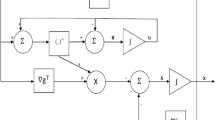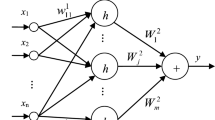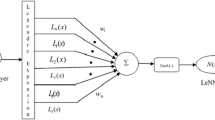Abstract
Linear systems of equations have many applications in the area of engineering sciences, mathematics, operations research and statistics. It is worth mentioning that the coefficient matrix of the linear systems of equations may not be always crisp due to various uncertainties. These uncertainties may be in the form of interval. Likewise, the solution set and right hand side vector may also be in interval. In this respect, a fully interval linear system of equations \( (\tilde{P}\tilde{z} = \tilde{q}) \) is one where the coefficient matrix, the unknown vector and the right hand side vector all are in the form of interval. Although various authors proposed different methods to handle the fully linear systems of equations but those are sometimes problem specific etc. As such, in this paper \( n \times n \) fully interval linear systems of equations has been solved based on artificial neural network (ANN) model. In this regard, step by step algorithm has been included. Further, a convergence theorem has also been discussed for choosing suitable learning parameter. Few numerical examples and an application problem related to electrical circuit have been solved using the proposed method. Detail procedure has been discussed with numerical results to show the efficacy and powerfulness of the method.




Similar content being viewed by others
References
Abolmasoumi S, Alavi M (2014) A method for calculating interval linear system. J Math Comput Sci 8:193–204
Allahdadi M, Khorram Z (2015) Solving interval linear equations with modified interval arithmetic. Br J Math Comput Sci 10(2):1–8
Das S, Chakraverty S (2012) Numerical solution of interval and fuzzy system of linear equations. Appl Appl Math Int J 7:334–356
Karunakar P, Chakraverty S (2018) Solving fully interval linear systems of equations using tolerable solution criteria. Soft Comput 22(14):4811–4818
Krämer W (2007) Computing and visualizing solution sets of interval linear systems. Serdica J Comput 1(4):455–468
Kolev LV (2004) A method for outer interval solution of linear parametric systems. Reliable Comput 10(3):227–239
Beaumont O (1998) Solving interval linear systems with linear programming techniques. Linear Algebra Appl 281(1–3):293–309
Skalna I (2003) Methods for solving systems of linear equations of structure mechanics with interval parameters. Comput Assist Mech Eng Sci 10(3):281–293
Hansen ER (1992) Bounding the solution of interval linear equations. SIAM J Numer Anal 29(5):1493–1503
Zhen J, Den Hertog D (2017) Centered solutions for uncertain linear equations. CMS 14(4):585–610
Siahlooei E, Shahzadeh Fazeli SA (2018) Two iterative methods for solving linear interval systems. Appl Comput Intell Soft Comput 2018:1–14
Siahlooei E, Shahzadeh Fazeli SA (2018) An application of interval arithmetic for solving fully fuzzy linear systems with trapezoidal fuzzy numbers. Adv Fuzzy Syst 2018:1–11
Nayak S, Chakraverty S (2013) A new approach to solve fuzzy system of linear equations. J Math Comput Sci 7(3):205–212
Dehghan M, Hashemi B (2006) Solution of the fully fuzzy linear systems using the decomposition procedure. Appl Math Comput 182(2):1568–1580
Alefeld G, Kreinovich V, Mayer G (2003) On the solution sets of particular classes of linear interval systems. J Comput Appl Math 152(1):1–15
Moore RE, Kearfott RB, Cloud MJ (2009) Introduction to interval analysis. Society for Industrial and Applied Mathematics, Philadelphia
Alefeld G, Herzberger J (1983) Introduction to interval computations. Academic Press, New York
Neumaier A (1990) Interval methods for systems of equations. Cambridge University Press, Cambridge
Cichocki A, Unbehauen R (1992) Neural networks for solving systems of linear equations and related problems. IEEE Trans Circuits Syst I Fundam Theory Appl 39(2):124–138
Zhou Z, Chen L, Wan L (2009) Neural network algorithm for solving system of linear equations. In: Computational intelligence and natural computing. CINC’09. International conference on IEEE, vol 2, pp 7–10
Viet NH, Kleiber M (2006) AI methods in solving systems of interval linear equations. In: International conference on artificial intelligence and soft computing, pp 150–159. Springer, Berlin
Abbasbandy S, Otadi M, Mosleh M (2008) Numerical solution of a system of fuzzy polynomials by fuzzy neural network. Inf Sci 178(8):1948–1960
Buckley JJ, Eslami E, Hayashi Y (1997) Solving fuzzy equations using neural nets. Fuzzy Sets Syst 86(3):271–278
Otadi M, Mosleh M (2011) Simulation and evaluation of dual fully fuzzy linear systems by fuzzy neural network. Appl Math Model 35(10):5026–5039
Otadi M, Mosleh M, Abbasbandy S (2011) Numerical solution of fully fuzzy linear systems by fuzzy neural network. Soft Comput 15(8):1513–1522
Rajchakit G, Pratap A, Raja R, Cao J, Alzabut J, Huang C (2019) Hybrid control scheme for projective lag synchronization of Riemann–Liouville sense fractional order memristive BAM neural networks with mixed delays. Mathematics 7(8):759
Huang C, Liu B (2019) New studies on dynamic analysis of inertial neural networks involving non-reduced order method. Neurocomputing 325:283–287
Tang R, Yang X, Wan X (2019) Finite-time cluster synchronization for a class of fuzzy cellular neural networks via non-chattering quantized controllers. Neural Netw 113:79–90
Yang X, Yang Z (2014) Synchronization of TS fuzzy complex dynamical networks with time-varying impulsive delays and stochastic effects. Fuzzy Sets Syst 235:25–43
Wang LX, Mendel JM (1992) Back-propagation fuzzy system as nonlinear dynamic system identifiers. In: IEEE international conference on fuzzy systems, pp 1409–1418
Yang X, Zhu Q, Huang C (2011) Generalized lag-synchronization of chaotic mix-delayed systems with uncertain parameters and unknown perturbations. Nonlinear Anal Real World Appl 12(1):93–105
Huang C, Su R, Cao J, Xiao S (2019) Asymptotically stable of high-order neutral cellular neural networks with proportional delays and D operators. Math Comput Simul. https://doi.org/10.1016/j.matcom.2019.06.001
Huang C, Liu B, Tian X, Yang L, Zhang X (2019) Global convergence on asymptotically almost periodic SICNNs with nonlinear decay functions. Neural Process Lett 49(2):625–641
Chakraverty S, Hladík M, Mahato NR (2017) A sign function approach to solve algebraically interval system of linear equations for nonnegative solutions. Fund Inf 152(1):13–31
Behera D, Chakraverty S (2015) New approach to solve fully fuzzy system of linear equations using single and double parametric form of fuzzy numbers. Sadhana 40(1):35–49
Ning S, Kearfott RB (1997) A comparison of some methods for solving linear interval equations. SIAM J Numer Anal 34(4):1289–1305
Chakraverty S, Tapaswini S, Behera D (2016) Fuzzy differential equations and applications for engineers and scientists. CRC Press, Boca Raton
Rahgooy T, Yazdi HS, Monsefi R (2009) Fuzzy complex system of linear equations applied to circuit analysis. Int J Comput Electr Eng 1(5):535–541
Author information
Authors and Affiliations
Corresponding author
Additional information
Publisher's Note
Springer Nature remains neutral with regard to jurisdictional claims in published maps and institutional affiliations.
Rights and permissions
About this article
Cite this article
Jeswal, S.K., Chakraverty, S. ANN Based Solution of Uncertain Linear Systems of Equations. Neural Process Lett 51, 1957–1971 (2020). https://doi.org/10.1007/s11063-019-10183-w
Published:
Issue Date:
DOI: https://doi.org/10.1007/s11063-019-10183-w




